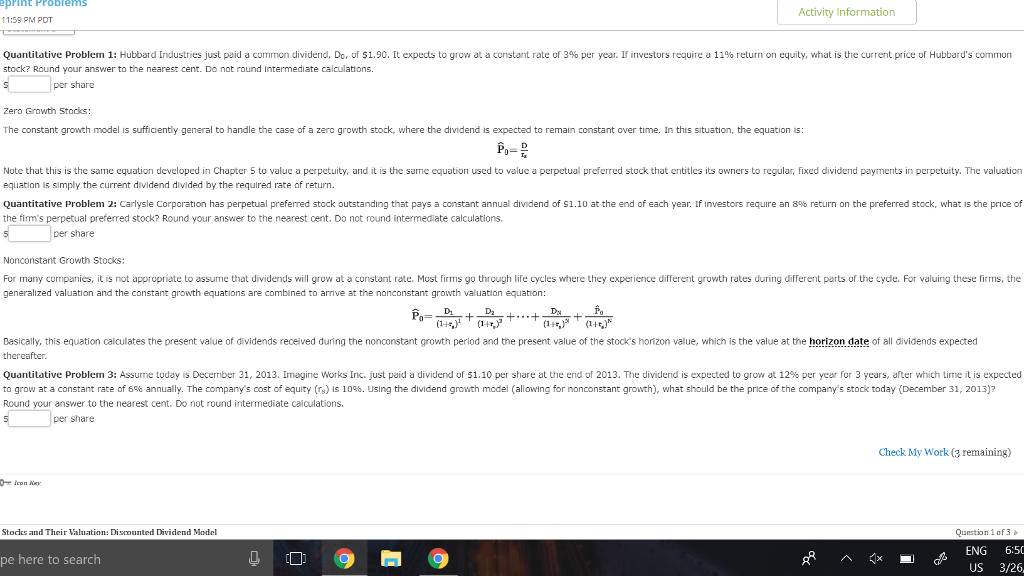 Please help on Quantitative Problems 1, 2, 3
Please help on Quantitative Problems 1, 2, 3
print Problems 11:59 PM PDT Activity Information uantitative Problem 1: Hubbard Industries Just paid a common dividend Do of $1.90. It expects to grow a a constant rate of 39 per year stock? Round your answer to the nearest cent. Do not round intermediate calculations. investors require a 11% return on equity, what is the current price of Hubbard's cornmon per share Zero Growth Stocks: The constant growth model is sufficiently general to handle the case of a zero growth stock, where the dividend is expected to remain constant over time. In this situation, the equation is: Note that this is the same equation developed in Chapter 5 to value a perpetuity, and it is the sarie equation used to value a perpetual preferred stock that entitles its owners to regular, fixed dividend payments in perpetuity. The valuation equation Is simply the current dividend divided by the required rate of return. Quantitative Problem 2: Carlysle Corporation has perpetual preferred stock outstanding that pays a constant annual dividend of S1.10 at the end of each year. If investors require an 8% return on the preferred stock, what is the price o the firms I preferred stock? Round your answer to the nearest cent. Do nct round intermediate calculations. per share Nonconstant Growth Stocks: For many corrmpanies, it is not appropriate to assume that dividends will grow at a constant rate. Most firmis go through life cycles where they experience different growth rates during different parts of the cyde. For valuing these firms, the generalized valuation and the constant growth equations are combined to arrive at the nonconstant growth valuation equation: Basically, this equation calculates the present value of dividends received during the nonconstant growth period and the present value of the stock's horizon value, which is the value at the horizon date of all dividends expected uantitative Problem 3: Assume today s December 31, 2013. Imagine works in just paid a dividend of $1.10 per share at the end of 2013. The dividend is expected to grow at 12% per year for 3 years, after wh ch time it is expected to grow at a constant rate of 6% annually. The company's cost of equity r is 10%. Using the dividend growth model allowing or nonconstant growth what should be the price of the company's stock today December 31, 2013) Round r answer to the nearest cent. Do not round intermediate caloulations. per share Check My Work (3 remaining) Icon K Stodks and Their Valuation: Disrounted Dividend Model Question 1 of3 ENG 6:50 US 3/26, pe here to search
 Please help on Quantitative Problems 1, 2, 3
Please help on Quantitative Problems 1, 2, 3





